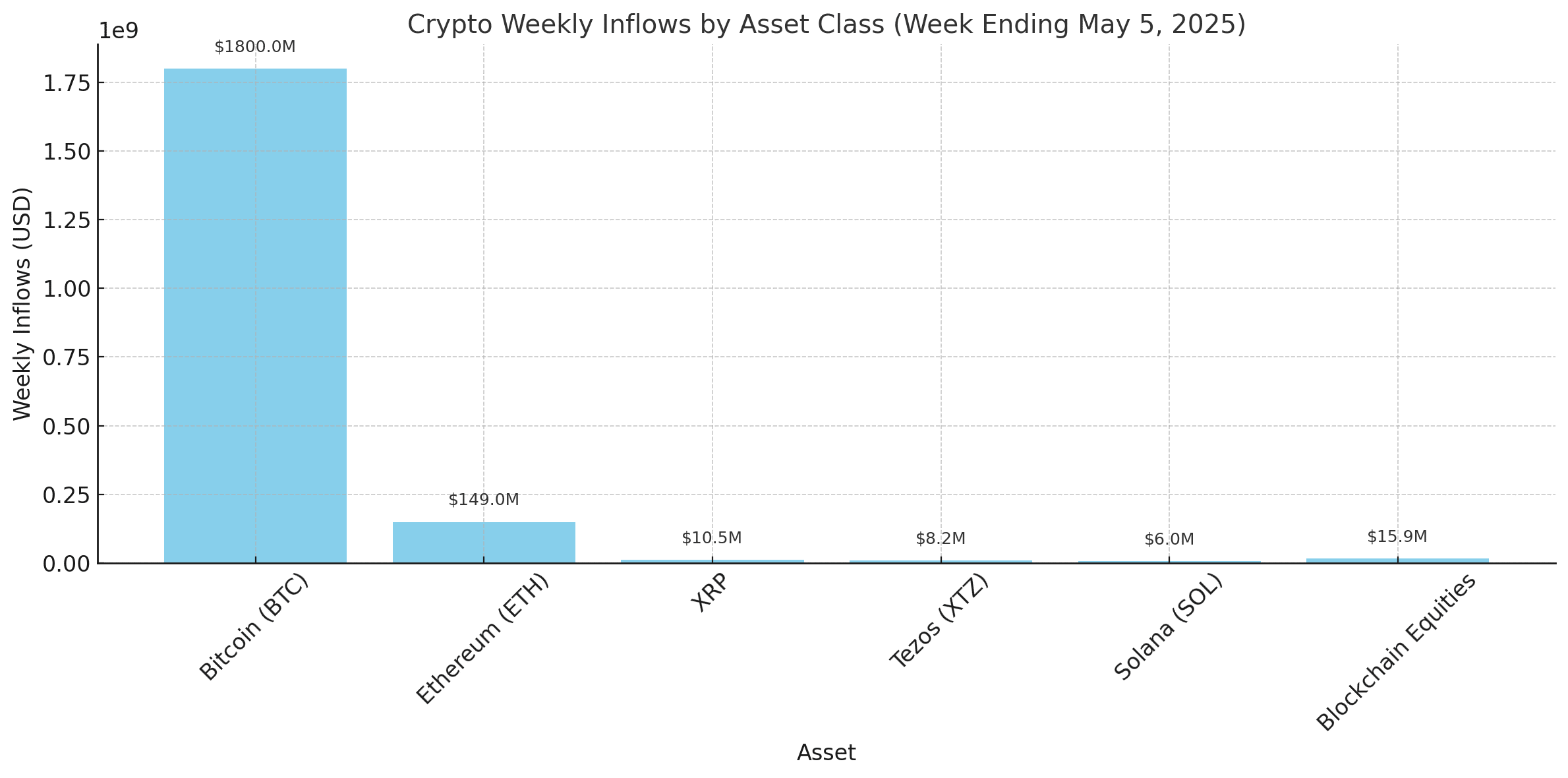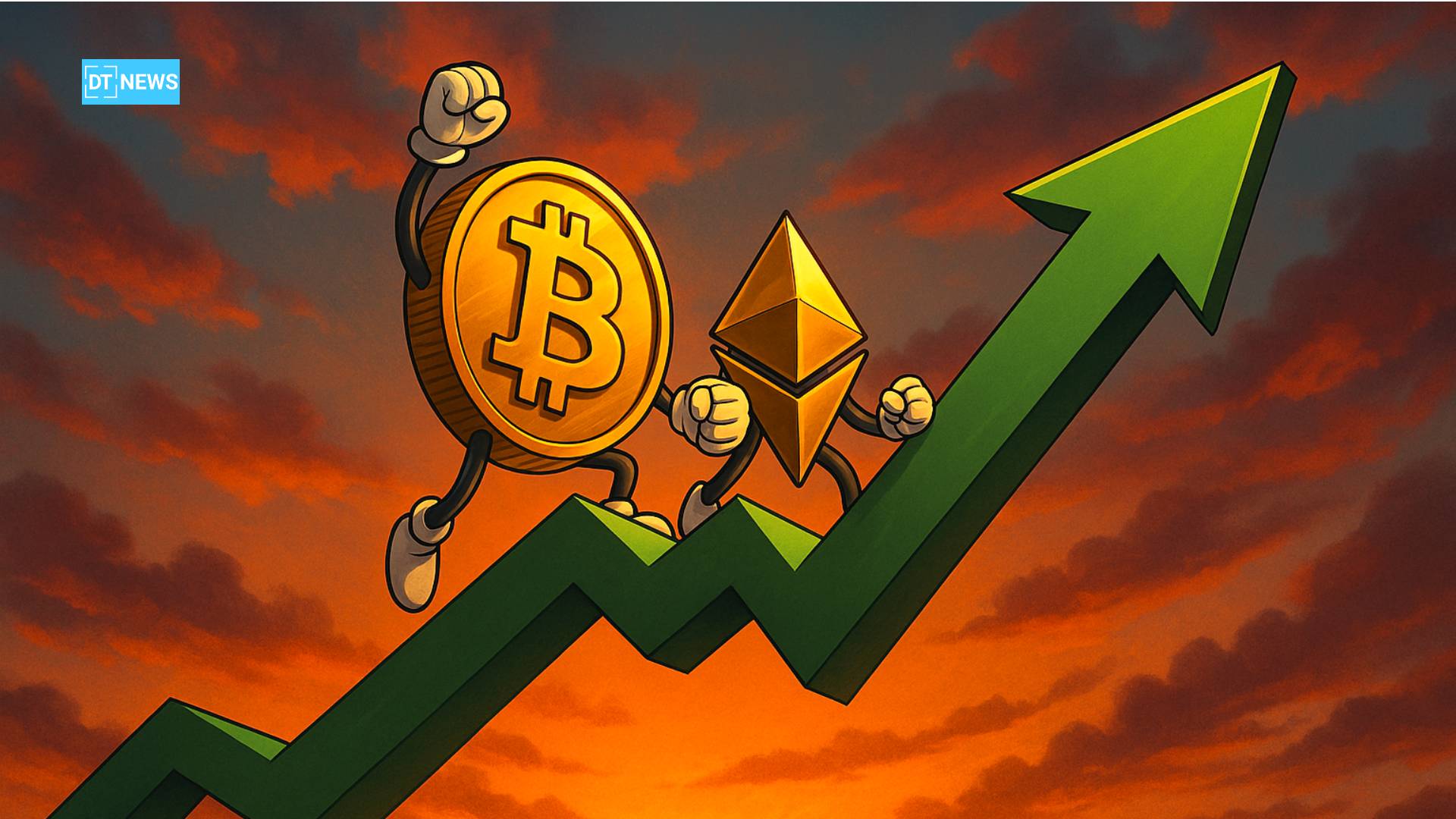After a sluggish Q1, institutional investors are back in full force, pumping an impressive $2 billion into digital asset investment products last week alone. The data, released by CoinShares, signals a massive confidence boost across the sector, and perhaps the beginning of a more sustained capital rotation into blockchain-based assets.
- Bitcoin Pulls $1.8B in One Week — ETF Influence Remains Strong
- Ethereum Sees Renewed Energy Ahead of Major Upgrade
- Crypto Investment Inflows (Week Ending May 5, 2025)
- Geopolitical Flows: U.S. Dominates, Europe and Canada Follow
- Altcoins and Equities Get a Modest Lift
- Is This the Start of a Crypto Bull Cycle?
- Final Thoughts: Institutions Are No Longer Sitting on the Sidelines
- Frequently Asked Questions (FAQs)
- What triggered the $2 billion inflow into crypto markets?
- Why is Bitcoin receiving the majority of institutional inflows?
- How is Ethereum attracting institutional capital right now?
- Glossary of Key Terms
Leading the charge? The usual titans: Bitcoin and Ethereum.
With macroeconomic tensions easing and spot ETF markets heating up, digital gold and programmable money are once again the primary vehicles for professional portfolios seeking asymmetric upside.
Bitcoin Pulls $1.8B in One Week — ETF Influence Remains Strong
Bitcoin (BTC) accounted for a whopping $1.8 billion of last week’s inflows — roughly 90% of the total.
That’s not just a bullish print; it’s a clear signal that institutions haven’t lost faith in Bitcoin’s long-term promise. What’s driving it? A convergence of factors:
Wider adoption of spot Bitcoin ETFs, especially in the U.S. and European markets
Increasing recognition of BTC as a hedge in uncertain economic environments
Regulatory tailwinds from the SEC’s evolving stance on digital assets
As of May 2025, BTC is trading at $94,390, a healthy 6.2% gain over the past week. While the market isn’t in full breakout mode yet, it’s showing signs of accumulation.
Notably, bearish sentiment hasn’t vanished completely. Short Bitcoin products saw $6.4 million in inflows, suggesting some investors remain cautious or are hedging against volatility.
Ethereum Sees Renewed Energy Ahead of Major Upgrade
Ethereum (ETH), often labeled the king of smart contracts, posted a two-week inflow total of $336 million, with $149 million added last week alone. That’s a meaningful uptick, especially considering the network’s recent performance plateau.

This uptick aligns with growing hype around the Pectra upgrade, Ethereum’s next big leap in scalability and staking efficiency. Developers have hinted at improved gas economics and validator incentives — features that could further entrench ETH as a blue-chip Web3 asset.
ETH is currently trading at $1,805, up nearly 5% from its April low. The broader Ethereum ecosystem is also gaining traction, with a resurgence in decentralized finance (DeFi) activity and layer-2 innovation.
“Ethereum’s fundamentals are strengthening just as institutional money is circling back. It’s a double catalyst scenario,” said Megan Cho, a portfolio strategist at ChainNode Capital.
Crypto Investment Inflows (Week Ending May 5, 2025)
| Asset | Weekly Inflows | Price |
|---|---|---|
| Bitcoin (BTC) | $1.8 billion | $$94,390 |
| Ethereum (ETH) | $149 million | $$1,805 |
| XRP | $10.5 million | $0.54 |
| Tezos (XTZ) | $8.2 million | $1.05 |
| Solana (SOL) | $6 million | $152.88 |
| Blockchain Equities | $15.9 million | N/A |
Geopolitical Flows: U.S. Dominates, Europe and Canada Follow
The United States accounted for $1.9 billion of the week’s inflows — a stark reminder of its gravitational pull in global finance.
Germany and Switzerland also saw healthy flows, $47 million and $34 million, respectively. Canada followed with $20 million. These numbers reinforce a global pattern: jurisdictions with clearer regulatory guidance are attracting the most capital.
The SEC’s recent change in leadership has also played a part. With Paul Atkins taking over as Chair, crypto-focused policies are shifting toward greater flexibility and innovation. That has likely emboldened U.S.-based institutions to reenter the market.
Altcoins and Equities Get a Modest Lift
While BTC and ETH stole the headlines, select altcoins quietly pulled in institutional interest.
XRP, Tezos, and Solana collectively added over $24 million in new capital, signaling interest in utility-driven tokens. With ongoing legal clarity for XRP and increasing DeFi adoption on Solana, this could be the early phase of an altcoin revival.

Meanwhile, blockchain-related equities — think mining firms, infrastructure providers, and fintech platforms — recorded $15.9 million in inflows, reflecting a broader bet on crypto’s underlying architecture.
“You can’t ignore how investor behavior is broadening. It’s no longer Bitcoin-only,” said analyst Jordan Wei of VegaChain Research.
Is This the Start of a Crypto Bull Cycle?
The $2 billion inflow isn’t just a technical bounce — it’s a signal.
Institutional portfolios, long absent or cautious, are beginning to rotate capital back into the crypto space. This isn’t retail-driven hype. This is regulated funds, pension allocators, and hedge desks reallocating.
Still, caution remains.
While inflows are encouraging, technical breakouts have yet to materialize across many top coins. Analysts suggest that a few more weeks of consistent inflows, combined with real-world catalysts like the Pectra upgrade and pending ETF approvals, could officially kick off a new cycle.
Final Thoughts: Institutions Are No Longer Sitting on the Sidelines
After months of fear, uncertainty, and doubt, it seems the big money is back in the crypto game. Bitcoin and Ethereum remain the cornerstones, but signs point toward a more diversified, data-driven market emerging in 2025.
From Wall Street to Zurich, investors are positioning themselves for what could be the next breakout phase, with Bitcoin as the beacon, Ethereum as the engine, and altcoins as speculative accelerants.
The question now is: Will the momentum hold?
Frequently Asked Questions (FAQs)
What triggered the $2 billion inflow into crypto markets?
The surge is primarily driven by renewed institutional confidence, favorable U.S. regulatory shifts, and growing interest in ETF products linked to Bitcoin and Ethereum.
Why is Bitcoin receiving the majority of institutional inflows?
Bitcoin is widely viewed as a digital store of value. Recent inflows are tied to the growing adoption of spot BTC ETFs and a shift toward regulatory clarity in the U.S. and Europe.
How is Ethereum attracting institutional capital right now?
Ethereum’s upcoming Pectra upgrade, which aims to improve scalability and staking efficiency, has reignited investor interest. ETH saw $336M in inflows over two weeks.
Glossary of Key Terms
Institutional Inflows: Large-scale capital investments from professional investors or organizations, including hedge funds and asset managers, into crypto markets.
Spot ETF (Exchange-Traded Fund): A financial product that allows investors to gain exposure to an asset, like Bitcoin, by tracking its real-time market price on regulated exchanges.
Pectra Upgrade: An anticipated Ethereum network enhancement designed to reduce gas fees, boost scalability, and improve staking rewards in 2025.
Altcoins: Any cryptocurrencies that are not Bitcoin — includes Ethereum, XRP, Solana, Tezos, etc.
Blockchain Equities: Publicly traded companies involved in the blockchain and crypto ecosystem, such as mining firms, DeFi platforms, or crypto exchanges.
Short Bitcoin Products: Derivative instruments that profit when Bitcoin’s price declines, often used as a hedge against volatility.
Market Sentiment: The overall attitude or feeling that investors have toward a particular asset or market, typically measured by inflows, price action, or trading volume.



















































































































